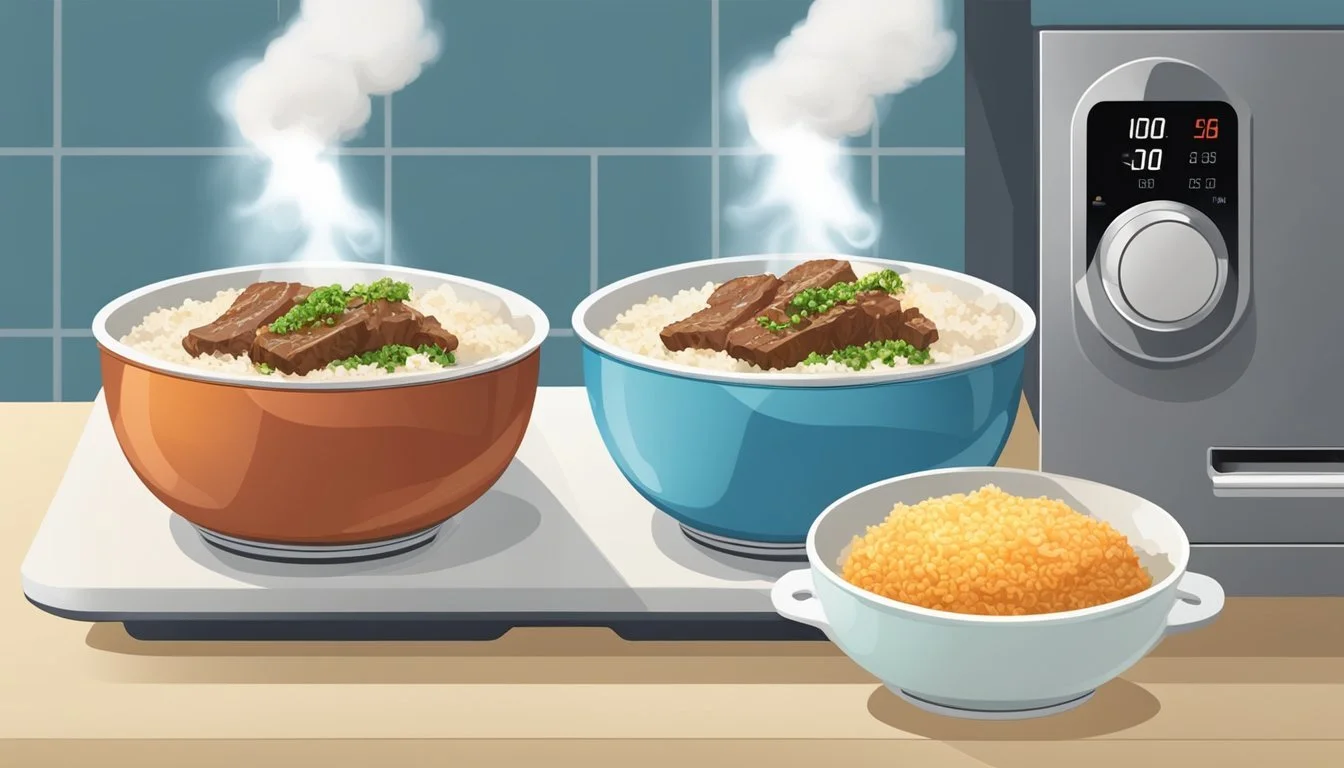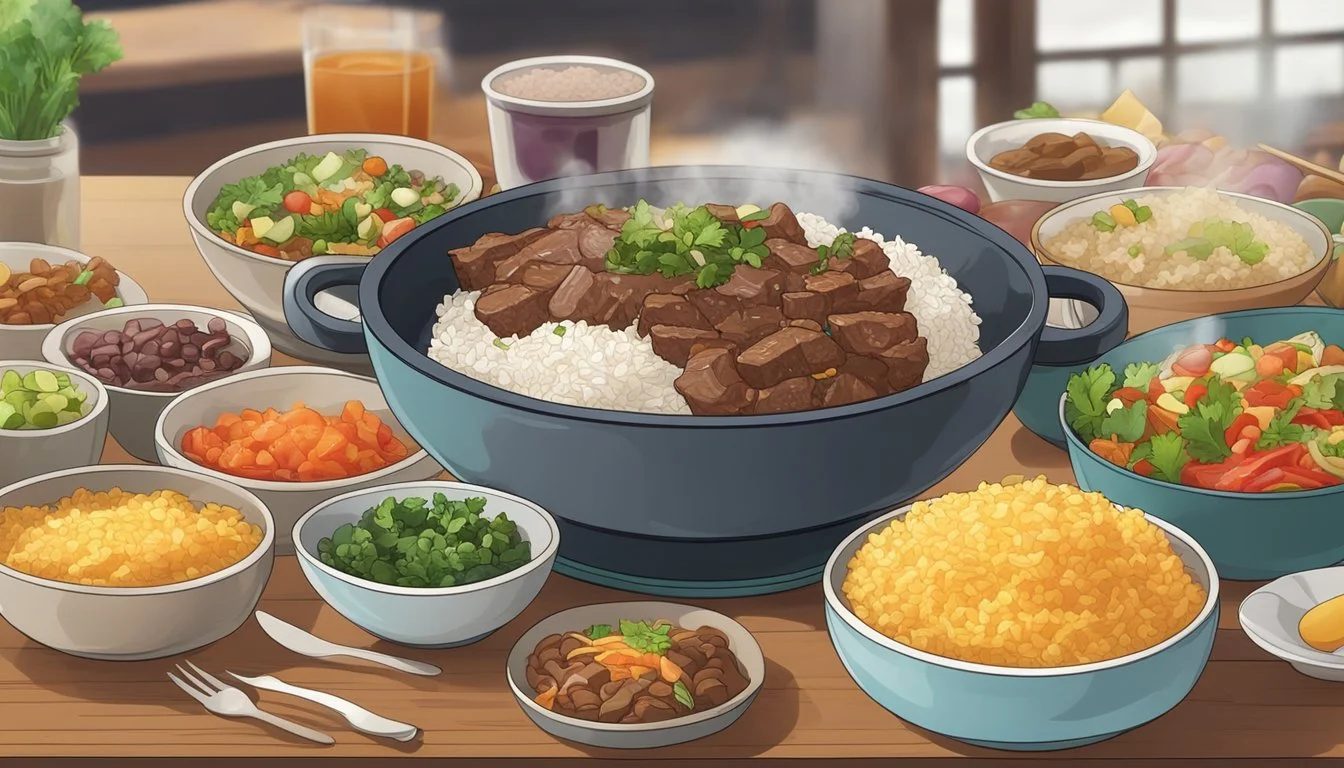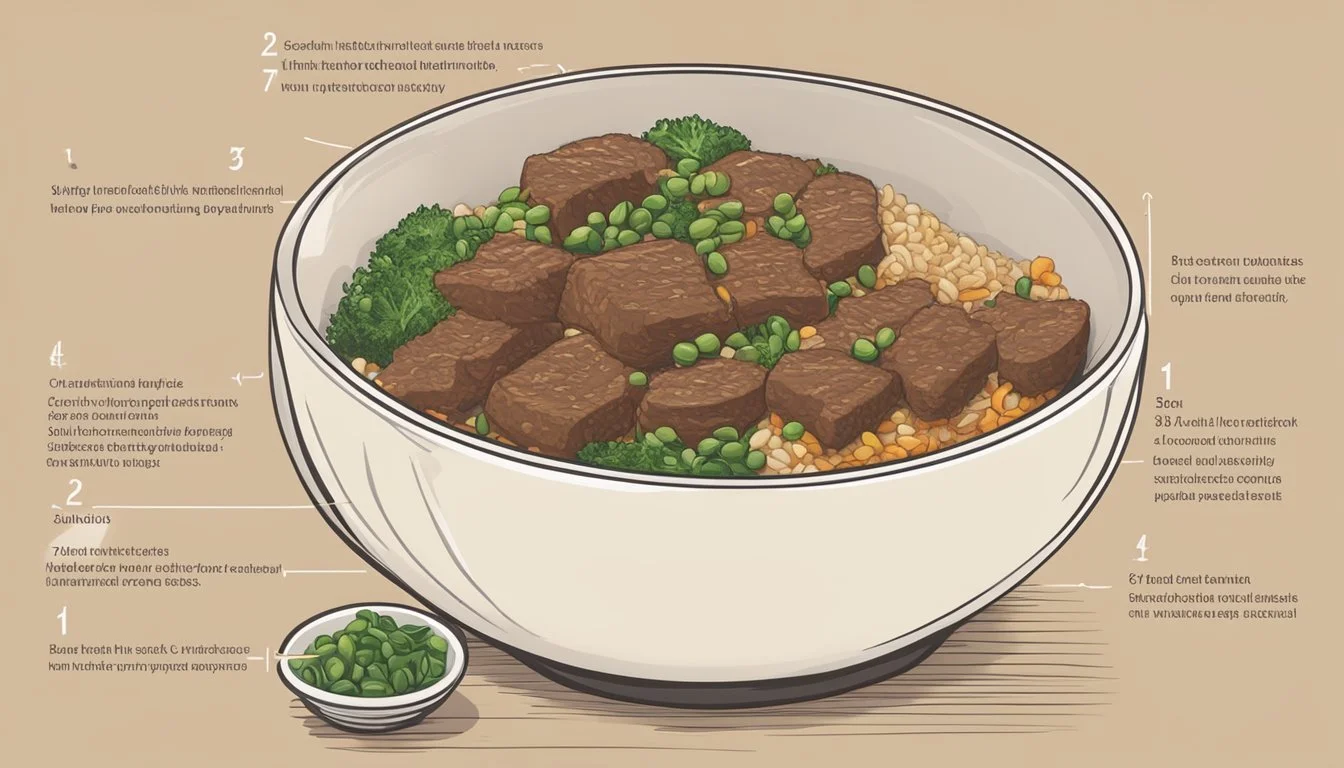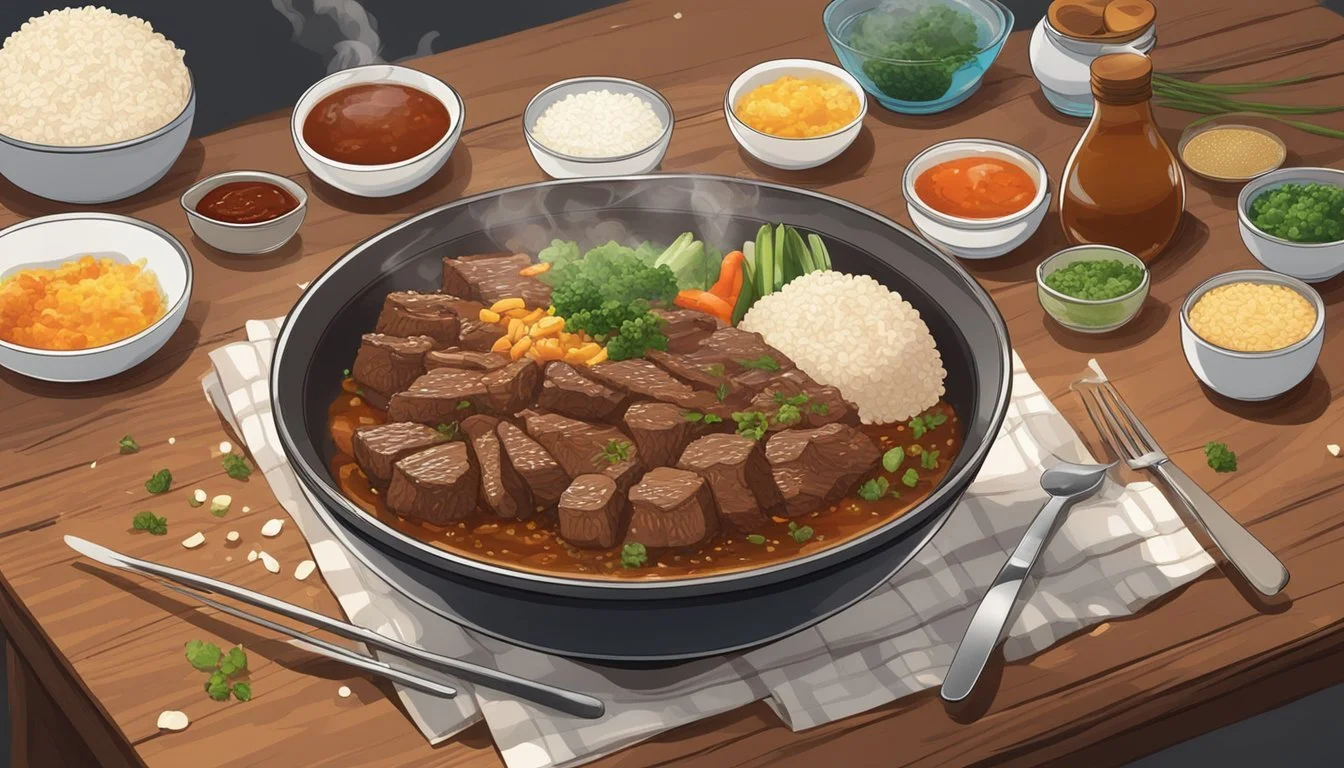How to Reheat Beef and Rice Bowls
Simple and Effective Methods
Reheating beef and rice bowls can be a challenge, especially if you want to preserve the flavors and textures of the original meal. This beloved dish, often enjoyed as a quick weeknight dinner or pre-prepared meal, deserves proper handling to stay delicious. To reheat beef and rice bowls without losing their moisture and taste, follow the right techniques.
Using a microwave is the most convenient method. Place the beef and rice in a microwave-safe dish, add a splash of water or broth, and cover it loosely with a damp paper towel. Heat on high in short intervals, stirring in between to ensure even heating.
For a more thorough reheating, consider the oven. Transfer the beef and rice to an oven-safe dish, cover with foil, and bake at 300 degrees Fahrenheit for 15-20 minutes. Adding a bit of liquid will help retain moisture. With these tips, your beef and rice bowls will taste as flavorful as when they were first prepared.
Why Beef and Rice Bowls Make the Perfect Meal
Beef and rice bowls are a family favorite that meet the needs of a nutritious and convenient meal. They offer a balanced combination of protein and carbohydrates, making them satisfying and nutrient-rich.
Nutritional value is a key advantage. Beef is a great source of protein and iron, essential for muscle growth and energy. Rice, on the other hand, provides a good amount of carbohydrates, fueling the body.
Their flavorful nature makes them appealing. Ingredients like garlic, soy sauce, and ginger offer a delicious taste while allowing for various seasonings to suit different palates.
They are extremely versatile. Whether it's a Korean-inspired bowl with sesame oil and red pepper flakes, or a teriyaki-style bowl with vegetables, the variety is endless.
Beef and rice bowls are convenient for both meal prep and busy weeknight meals. They can be made in large batches, ensuring that there are always leftovers available for a quick and easy meal.
Here is a simple list of why they are preferred:
Nutritional value
Convenience
Versatility
Flavorful
Ideal for meal prep and leftovers
Combining all these factors, beef and rice bowls stand out as an ideal option for efficient and enjoyable meals.
Selecting Ingredients for Beef and Rice Bowls
Choosing the right ingredients can significantly enhance the flavor and nutritional value of beef and rice bowls. Factors such as the type of beef, rice, and additional vegetables play crucial roles.
Choosing the Best Beef
Selecting quality beef is essential. Ground beef is the most common option, available in various leanness levels. Lean ground beef is preferred for its lower fat content. Those looking for an alternative can opt for ground turkey or ground chicken, which offer leaner options while maintaining robust flavors.
Freshness is key. Purchase beef that is bright red with no discoloration. It's advisable to buy from a reputable source and use within a few days of purchase.
Types of Rice for the Perfect Bowl
Different rice types can alter the dish's texture and taste. White rice is a versatile base, known for its mild flavor and fluffy texture. Brown rice is a healthier alternative, offering more fiber and a slightly nutty taste. For aromatic options, jasmine rice provides a sweet fragrance.
For those seeking alternative grains, quinoa serves as a high-protein substitute, and cauliflower rice caters to low-carb diets while adding a subtle vegetable taste. Consider the flavor profile and dietary needs when choosing the rice.
Vegetables and Additional Ingredients
Adding vegetables not only enhances nutrition but also adds vibrant colors and textures. Common choices include onion, carrots, and peppers. These vegetables bring sweetness and crunch. Green onions work well as a garnish, adding a mild, fresh flavor.
Fresh garlic and ginger are essential for their aromatic qualities, though garlic powder can be a convenient substitute. Broccoli, cabbage, and leafy greens like spinach or bok choy offer additional texture and nutrients. Including a variety of vegetables ensures a balanced and flavorful bowl.
Using a mix of fresh and pantry staples can simplify preparation. Keep in mind the cooking times and textures to create a harmonious and satisfying beef and rice bowl.
Preparing Your Beef and Rice Bowl
Careful preparation is essential for crafting a flavorful and satisfying beef and rice bowl. This process involves cooking the rice to a fluffy consistency, ensuring the beef is perfectly tender, and blending ingredients with the right seasonings.
Cooking Rice to Perfection
Begin by rinsing the rice thoroughly under cold water to remove excess starch. This helps achieve a fluffier texture. Use a ratio of 1 cup of rice to 1.5 cups of water. Bring the water to a boil in a pot, then stir in the rice. Reduce the heat to low, cover, and simmer for about 15-20 minutes.
For added flavor, use chicken broth instead of water. Once cooked, let the rice sit covered for an additional 5 minutes before fluffing it with a fork. Season with a pinch of salt and a dash of sesame oil for extra taste.
Achieving the Perfectly Cooked Beef
Heat a large skillet or wok over medium-high heat and add sesame oil. Once hot, add ground beef and cook until it's nearly browned, around 6-10 minutes. Stir frequently to break up the meat and ensure even cooking.
Add minced garlic, fresh ginger, soy sauce, and a bit of brown sugar to enhance the beef's flavor. Continue cooking until the beef is fully browned and coated in the sauce. For a spicy kick, include red pepper flakes. Cook until the beef is tender and juicy.
Combining Ingredients and Seasoning
Combine the cooked rice and beef in a large bowl. Mix thoroughly to ensure even distribution. For added texture and flavor, top the bowl with sliced green onions, sesame seeds, and a drizzle of soy sauce or honey.
Adjust the seasoning with salt and pepper to taste. Add fresh vegetables like bell peppers, carrots, or snap peas for extra nutritional value and crunch. Serve immediately while warm to enjoy the best flavor and texture.
Create a balance of savory and sweet flavors by carefully choosing seasonings and garnishes. This careful combination will ensure each bite is satisfying and delicious.
Reheating Your Beef and Rice Bowl for Great Flavor
Reheating beef and rice bowls requires attention to maintain their texture and flavor. Different methods such as using a microwave, stovetop, or oven can achieve great results.
Microwave Reheating Techniques
To reheat beef and rice bowls in the microwave, first, transfer the leftovers to a microwave-safe container. For every serving, add a tablespoon of water or broth to prevent drying out. Cover the container with a microwave-safe lid or wrap it with a damp paper towel to lock in moisture.
Heat the dish on medium power for 1-2 minutes, then stir and check the temperature. Repeat until the desired warmth is achieved, ensuring the internal temperature reaches at least 165°F. This method is quick and convenient for single servings, making it a popular choice.
Stovetop Reheating Methods
Starting with medium heat, heat a non-stick skillet and add a small amount of oil to the pan. Spread the rice and beef evenly in the skillet. Stir occasionally to prevent sticking and to distribute the heat uniformly.
Add a splash of broth or water if needed to keep the dish moist. Reheat for about 5-7 minutes until steam rises and the meat is thoroughly heated. This method helps maintain the original texture and flavor, ideal for larger portions or multiple servings.
Oven Reheating Guide
For oven reheating, preheat the oven to 350°F. Place the beef and rice bowl in an oven-safe dish. Add a tablespoon of broth or water to keep the dish moist. Cover the dish tightly with aluminum foil to hold in moisture throughout the reheating process.
Bake for 15-20 minutes, stirring halfway through, until the dish is heated thoroughly. Ensure the internal temperature reaches at least 165°F before serving. This method is particularly effective for preserving flavor and texture, suitable for reheating multiple servings.
Proper Storage for Beef and Rice Bowls
To maintain the quality and taste of your beef and rice bowls, proper storage techniques are crucial. This section will guide you on the best practices for freezing, thawing, and storing servings in the refrigerator.
Freezing and Thawing Techniques
Freezing beef and rice bowls is an excellent option for long-term storage. Use airtight containers to prevent freezer burn and keep flavors intact. For best results, freeze the beef and rice separately to maintain the texture.
When thawing, move the containers from the freezer to the refrigerator and let them thaw slowly overnight. This method ensures even thawing and reduces the risk of bacterial growth. For quicker thawing, use a microwave on a low setting, stirring occasionally to promote even heating.
Enhancing Your Bowls with Variations and Toppings
Adding the right toppings and exploring creative variations can elevate your beef and rice bowls from a simple meal to a culinary experience. Look for flavors, textures, and colors to create a balanced and delicious dish.
Delicious Topping Options
Kimchi: This fermented Korean staple adds a tangy and spicy kick. It's perfect for adding flavor and crunch to your bowl.
Sriracha: A drizzle of this hot sauce provides an extra layer of heat and flavor.
Fried Egg: Adding a runny yolk can enrich the bowl, contributing creamy texture and additional protein.
Green Onions: These provide a fresh and slightly sharp flavor that complements the beef.
Crushed Red Pepper Flakes: For those who appreciate heat, these flakes offer an extra spicy dimension.
Bean Sprouts: They add a refreshing crunch and a mild flavor.
Cucumber: Thin slices offer a cooling, crisp texture, balancing spicier elements.
Bell Peppers: Whether red, green, or yellow, they add color and a sweet crunch.
Creative Rice Bowl Variations
Bibimbap: A classic Korean rice bowl that includes seasoned vegetables, beef, a fried egg, and spicy gochujang sauce.
Lettuce Wraps: Use lettuce leaves to wrap portions of rice and beef for a low-carb variation.
Quinoa Substitution: Replace rice with quinoa for a protein-packed and gluten-free option.
Coconut Aminos: Use in place of soy sauce for a slightly sweeter and less salty flavor.
Tamari: A gluten-free soy sauce alternative that offers a rich umami taste.
Using Different Proteins: Swap ground beef with chicken, tofu, or shrimp for variety.
Adding Bean Sprouts and Other Vegetables: Enhance the nutritional value and texture by including vegetables like carrots, zucchini, and mushrooms.
With these toppings and variations, you can personalize your beef and rice bowls to meet dietary preferences and flavor profiles.
Serving and Presentation
When serving beef and rice bowls, the main course should be visually appealing and inviting.
Steps for Serving Beef and Rice Bowls:
Use a Wide, Shallow Bowl: This type of bowl allows the various components to be displayed clearly.
Start with a Base of Rice: Spread the rice evenly to form a stable base.
Add Beef: Place the beef over the rice in a generous portion.
Presentation Tips:
Garnishes: Top with sesame seeds, green onions, or fresh herbs for added color and texture.
Vegetable Arrangement: Include sections of colorful vegetables like bell peppers, carrots, and red onions to enhance visual appeal.
Sauce Drizzle: Add a light drizzle of teriyaki sauce for a glossy finish.
Example Layout:
Component Position on Plate Rice Base Beef Center Vegetables Around the edges Garnishes Sprinkled on top
This method ensures that each serving is appealing, appetizing, and balanced in presentation.
Nutritional Information
Reheating beef and rice bowls is not only convenient but also retains much of their original nutritional value. Here is a detailed breakdown.
Calorie Count and Protein Content
Beef and rice bowls are a balanced meal, generally providing a significant amount of calories and protein. A typical portion of beef and rice (approximately one cup of cooked rice with a serving of beef) can contain:
Calories: Around 400-600 calories, depending on the portion size and additional ingredients such as vegetables or sauces.
Protein: These bowls offer a substantial protein intake, ranging from 25-30 grams per serving, primarily from the beef.
This protein content supports muscle repair and growth. The rice contributes to the calorie count but is lower in protein compared to beef.
Vitamins and Minerals Composition
In addition to calories and protein, beef and rice bowls are a good source of essential vitamins and minerals:
Iron: Beef is high in iron, which is crucial for transporting oxygen in the blood. A serving can provide around 15% of the daily iron requirement.
Vitamins: Vegetables such as bell peppers and onions add significant vitamins, particularly Vitamin C, which boosts the immune system.
Minerals: These bowls also contain important minerals like zinc and magnesium from both beef and vegetables.
Inclusion of vegetables enhances fiber and vitamin intake, essential for a balanced diet.
Tips and Tricks for Perfect Beef and Rice Bowls Every Time
Preparing beef and rice bowls can be seamless and satisfying with these tips. Focus on timing, moisture retention, and flavor harmony for the best meal prep results, especially during busy weeknights.
Cooking Rice Ahead of Time
Cooking rice ahead of time can be a game-changer for meal prep recipes.
Prepare a large batch of rice once a week and store it in an airtight container in the fridge. Use a ratio of 1:2 rice to water for fluffy, tender grains. Avoid overcooking to maintain a firm texture.
When reheating, add a splash of water and cover the rice with a damp paper towel to keep it moist. This approach saves time and ensures your rice is flavorful and perfect, even on busy weeknights.
Maintaining Moisture in Beef and Rice
Maintaining moisture is crucial for tender, flavorful beef tips and rice.
After cooking, store beef tips in their gravy to retain moisture. When reheating, ensure you warm them over medium heat and stir occasionally to distribute the heat evenly. This prevents the beef from drying out, keeping it tender.
If using a microwave, cover the dish with a microwave-safe cover and stir halfway through the heating process. This method helps the beef and rice retain their juiciness and prevents any dryness.
Balancing Flavors and Seasonings
Balance flavors and seasonings to elevate your beef and rice bowls.
Start with high-quality beef cuts for the most tender bites. Season the beef generously with salt, pepper, and any preferred spices before cooking. Incorporate flavorful elements like onions, mushrooms, or garlic for added depth.
Taste the dish throughout the cooking process to adjust seasonings. Adding a splash of soy sauce or a dash of Worcestershire sauce can enhance the savory profile. Always aim for a harmonious blend of flavors to make your bowls delightful every time.
Cooking rice ahead, keeping beef moist, and balancing flavors will ensure delicious, stress-free meals.









